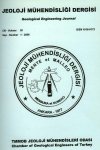
ABSTRACT: Karaali hot water is located 32 km south-eastern of Þanlýurfa Province, in Karaali Village at the eastern part of Yardýmcý County. Drilling logs show that the hot water is obtained from limestone used extensively for production of cold water. It has been considered that ascending hot water throughout these fault lines is spreading in to limestone aquifer by mixing with cold water, and because of this process temperature of hot water is decreased. Determination of the temperature of Karaali hot water before mixing has been purposed by this investigation. In the scope of that, mixing percentage of the hot and cold waters has been determined by using of the water chemistry data in silica-enthalpy mixing model (SEMM) and Cl-enthalpy graph. Initial (before mixing with cold water) chemical composition of Karaali hot water has been determined by this mixing percentage. Estimated reservoir temperature (ERT) of the hot water has been calculated by using of the initial chemical composition in silica and cation geothermometers. Calculated ERT (132°C) by silica-enthalpy mixing model (SEMM) is quite harmonious with the average of the Na-K and SiO geothermometers` results (138°C and 132°C, respectively) which were applied to 18% hot and 82% cold water mixing. The ERT and mixing percentage of hot water inspected by SEMM, mixing calculation and geothermometers has to be supported by the other investigations including detail mapping, geophysical investigations, detail water chemistry etc.
ABSTRACT: The terrigenous sedimentary rocks of Neogene intercalated with tuffs are widespread in the west of Kırkağaç (Manisa). According to detail petrographical studies, the tuff samples are generally named as dasitic vitric ash tuff considering principles of description. The crystal tuff and lithic tuff are occasionally described. Tuffs are determined to have dasitic character according to diagram showing mineral compositions but some tuff samples represent the products of andesite volcanism.
ABSTRACT: The lacustrine limestones of Miocene outcrop in the west of Güney town of denizli. Flüvial fan,sandstone and mudstone deposits of allüvial fan underlying lacustrine limesstones. 10 to 15 m thickbedded massive limestones are grey, beige, white, thick layered, karstic which are filled with calcite. As aresult of major oxide analyses 0.8-1.7. %SiO , 0. 3 %Al O , 0. 1-0.2 %Fe O , 0.5-0.9 % MgO, 52-55%CaO, and 42.9-43.6 % LOI. Low amount of heavy metals (Hg, Ni, Cr, Pb, As, Cd, Cu, Mo, Zn, Sb, Se,Sc)and radioactive elements were observed in the analysis of trace and detailed NTE.2 23 23Because of micritic matrix, the limestone produces well plates with its good edges and corners noshowing fragmentation and producing regular cutting surfaces except cavities holes. The rock cansuccesfully be polished. The limestone has a unit weight of 24.73 kN/m3, water absorption by weight of1.54%, effective porosity 5%, dry uniaxial compressive strength is 85.8 Mpa, weight loss due to freezethaw of 0.05, Böhme abrasion resistance of 0.74 cm/50 cm . No indication of oxidation is on the rockdetected. Limestone with low effective porosity and water absorption can be used as a natural buildingstone.
ABSTRACT: The Black Sea Region has a rich karstic cave potential. Some of these caves especially located the Eastern Black Sea Region have been assessed as tourism potential. Yazkonaðý Cave locates in 4 kilometers south of Ünye (Ordu) in the Eastern Black Sea Region. The cave forming underground system and located bottom of Pliocene erosion level was formed in Last Cretecaus-Paleocene aged unit consisting of limestone sandy limestone, sandstone and claystones and through the east-west directed vertical fault. Entrance of Yazkonaðý Cave with 900 meters length is located 85 meters altitude from sea level and 30 meters altitude from valley basin and it is about 900 meters. Yazkonaðý Cave divides in to two different parts according to entrance point. Direction of the main gallery is toward the south at first from the entrance and changes direction toward to west and it is narrow and has high altitude. The second gallery of the cave, in the contrary of main gallery, is toward to the northwest and it changes toward to the west. This gallery is better than main gallery considering the touristical features because it has different travertine forms and it is larger than main gallery. Although some structural conditions, the cave is very nice because there is a cavity with 8 meters diameter and 26 meters height in central part of the cave and there is a waterfall and groundwater flowing in this cavity.

 TMMOB
TMMOB